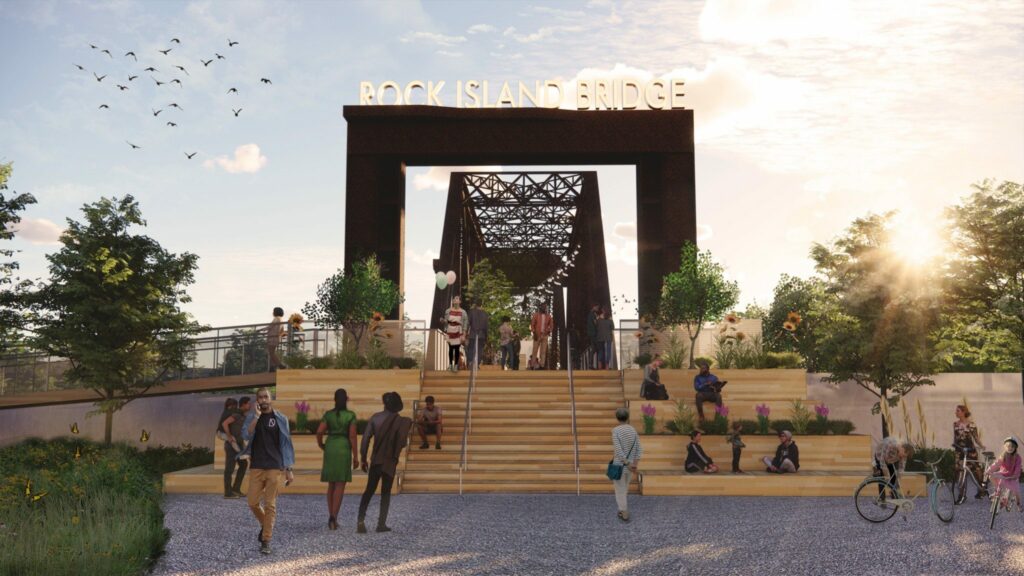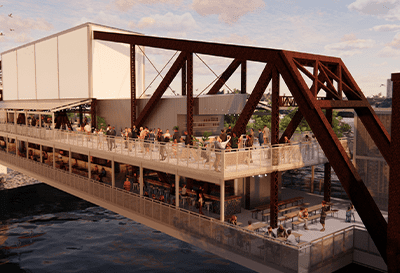KANSAS CITY, Kan., Jan. 31, 2023 – Local start-up firm, Flying Truss LLC today announces it has entered into a long-term lease with the Unified Government of Wyandotte County and Kansas City, Kansas (UG). The lease officially kicks off construction for redeveloping the City’s historic Rock Island Railroad Bridge over the Kansas River into the world’s first “destination landmark bridge.”
Mike Zeller, founder of Flying Truss, says, “Reinvented things are just more fun. And, what could be more fun than catching a band while enjoying some great KC BBQ and a drink on an old railroad bridge over a river?”
 Flying Truss is contracting L.G. Barcus and Sons of Kansas City, Kansas to construct the new steel and concrete decks. Under a separate contract with the UG, Barcus is permanently elevating the bridge four feet, so it is above the height of the levees. The US Army Corps of Engineers is raising the levees.
Flying Truss is contracting L.G. Barcus and Sons of Kansas City, Kansas to construct the new steel and concrete decks. Under a separate contract with the UG, Barcus is permanently elevating the bridge four feet, so it is above the height of the levees. The US Army Corps of Engineers is raising the levees.
Dan Gibson, vice president of estimating says, “We’re excited to be back on the bridge. In July of 1951, our founder, Lewis Grant Barcus, installed the screw-lift gates capable of raising each of the three trusses six feet in advance of flood waters. Seventy-two years and four generations later, we are back using those original gears and supports to permanently raise the bridge another four feet.”
The bridge, which sits just a few feet from the state line, will convey pedestrians and dismounted cyclists from KCK to KCMO, be the first to provide trailhead services above a river, and anchor the western leg of the emerging Green Line trail around downtown KCMO. It also will provide spaces for community organizations working in ways that help activate the trails and the river (biking, boating and nature groups).
Flying Truss also plans to host regattas, festivals and seasonal markets on the bridge. Bringing private enterprise into the mix both activates the space and generates the revenue needed to maintain the new decks and the trailhead services.
“It’s kind of an obvious idea, but no one in modern times has treated a bridge over a river like it was land,” says Zeller. “This full-on entertainment district will be equipped with commercial kitchens, bars and coffee shops, event spaces, retail, gardens, dance floors and art . . . forty feet over the Kansas River. Everyone is welcome to come and work remotely, read a novel, or just enjoy the views. Think of this as a steel park over a river with some really nice amenities.”

In March, Barcus begins removing the old ties and 1,400 feet of rails, lifting the bridge, and then placing some 400 tons of steel and even more concrete to create a new platform across the river. To make it wider in places, heavy steel beams will cantilever out an additional 12 feet from the sides of the bridge, and there is a double-decker platform above the middle of the river. Centric will take over construction in late summer, building the structures and finishes.
The original bridge was a wood-pile structure erected in 1882 by the Rock Island Railway to shuttle livestock in and out of the Kansas City Stockyards, which at that time was the second-largest cattle yard in the world. The structure was swept away in The Great Flood of 1903 despite heroic efforts to hold down the bridge with a steam locomotive. The present bridge began service in 1905.
TranSystems, a local engineering firm, inspected the bridge and found it needed only $65,000 in repairs even though it hasn’t been used since the 1970s. This is due to the robust structure, which was built to carry locomotives, and the fact that railroad bridges are never salted in winter. So the rust tends to be superficial.
Infrastructure renewal projects like Rock Island Bridge can deliver outsized returns to a community and everyone involved. But, they are expensive to get going. The UG, which owns the bridge, and the State of Kansas are both participating as well. And, since 65 percent of the bridge is platted as public space, the Helzberg, Sunderland and Dickinson Foundations are helping construct this through a charitable fund at the Greater Kansas City Community Foundation.
Local firms, including Lathrop GPM, Multistudio (formerly Gould Evans), Merkle (formerly DEG), BlueScope Steel and EAG Advertising & Marketing, have donated collectively more than $600,000 in labor and materials.
Kansas-City-proud investors, David and Cathi Brain, Neal and Angela Sharma and Ann and Bob Regnier among many others, are investing in the project through Flying Truss. “With this one project, we’re going to preserve our history, enhance public health, light up one of our big rivers and share a lot of fun. And it’s a smart investment.” says David Brain, founder of Entertainment Properties REIT (NYSE, EPR). “We’ve got a world first right here in Kansas City.”
A groundbreaking ceremony with a keynote address by Kanas Governor Laura Kelly is being scheduled for early April, and a grand opening is slated for March 2024.
For more information:
Available for Interview:
- Michael Zeller, Founder & CEO – Flying Truss LLC
- David Brain, Lead Investor and Subject Matter Expert
